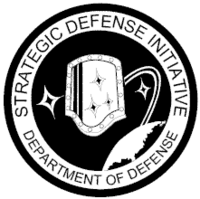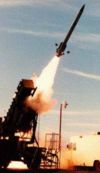Strategic Defense Initiative
 From Conservapedia
From Conservapedia The Strategic Defense Initiative (SDI), commonly called Star Wars, was a proposal made by U.S. President Ronald Reagan directly to the surprised American people in a televised addressed on March 23, 1983, to build a ground- and space-based system to protect the U.S. from nuclear ballistic missiles. The system has not yet been fully set up, but the research from this paved the way for the anti-ballistic missile systems of today, including the Patriot missile that provided the defense against Iraqi Scud missiles launched against American forces and Israel during the Gulf War. It is believed by some experts that panic among the leadership of the Soviet Union about SDI contributed to their financial and political collapse. (The Soviet Union was dominated by a hopeless atheistic, communist mindset.)
Phyllis Schlafly advocated for a missile defense system beginning as early as 1966, nearly two decades before Reagan adopted it. In a speech in October 1966, Phyllis Schlafly urged globalist Robert McNamara to drop his opposition to the Nike X missile defense program:
| “ | American technological genius has developed a marvelous new weapon which can give us the anti-missile defense we need. It is called the Nike X. It has been developed. and thoroughly tested, so that we know it is reliable and ready to go Into production. It consists of three parts. First there is MAR, or multi-function array radar, which is what separates the real missiles from the decoys. Then there is the Zeus, the long-range missile which goes out Into space and kills the enemy missile before it hits us. Finally, there is the Sprint, the short range missile which goes up and kills any enemy missile which might have gotten past Zeus. We have already spent a great sum of money in developing and testing the Nike X, under the direction of General Austin Betts, and it is ready to put into production. This Nike X has been unanimously recommended by the U.S. Joint Chiefs of Staff since early 1965. It has the near-unanimous support of the United States Congress. In May of this year, the House Armed Services Committee of 38 members. released a unanimous report which was an across-the-board indictment of the McNamara policies and specifically recommended appropriations to proceed with engineering on the Nike X. When this was presented to the Congress of the United States, it passed the House of Representatives by a vote of 356 to 2. and it passed the Senate by a vote of 81 to 1. But in spite of the fact that this weapon has been unanimously endorsed by the U.S. Joint Chiefs of Staff for more than a year, and has received this remarkable unanimity of support in Congress, Secretary McNamara and his clique of gravediggers are determined that we shall not have it. He is refusing to spend the money and is opposing the building of the anti-missile defense we need. | ” |
SDI was a major component of the Reagan Doctrine in foreign policy, designed to push the Soviets to its limits and beyond into collapse.
Contents
Goals of SDI[edit]
The basic goal of SDI was to intercept and destroy incoming nuclear ballistic missiles to prevent detonation over the U.S. In some scenarios, not all warheads would be intercepted, but enough would be to render mutually assured destruction moot. In the scenario of "partial protection", the U.S. would be immune from complete destruction, which would deter the USSR from launching a first strike. Also see game theory.
Components of SDI[edit]
There are a limited number of ways to prevent a ballistic missile from detonating over one's territory. A brief primer on nuclear attack will help explain the problems to be solved.
The Problems[edit]
Missiles with nuclear payloads are launched in two primary ways: as ground based intercontinental ballistic missiles, and as shorter range missiles, such as submarine-launched ballistic missiles (SLBMs) and submarine-launched cruise missiles (SLCMs).
- ICBMs are launched from the ground, travel into space, and return with the assistance of gravity. Most contain multiple independently targeted reentry vehicles or MIRVs. This means that a single ICBM can cause many nuclear warheads to detonate over multiple targets. Problems involved include detecting the launch, and deciding on what level to intercept the target. If the target is disabled before deployment of MIRVs, this obviously solves many problems. Once MIRVs are deployed, many more targets must be eliminated. Destroying an ICBM before it enters space is essentially impossible. Interception in space requires a pre-placed infrastructure. Interception after MIRV deployment involves ground-based systems.
- SLBMs and SLCMs present serious difficulties. SLBMs have a shorter time available to intercept, as they can be launched nearer to target. SLCMs are basically a first-strike weapon, travel short distances quickly and close to the ground.
The Solutions[edit]
Ground-based systems[edit]
Ground-based systems must be able to detect a rapidly-approaching ballistic object, and destroy or divert that object well enough to avoid catastrophic damage to the target.
Space-based systems[edit]
Space-based systems generally aim to destroy a ballistic missile at the height of its trajectory. At this point, the missile is fragile and vulnerable. The difficulty lies in detecting the object, deploying the countermeasure, and successful interception. Several solutions have been proposed, including "Brilliant Pebbles", which would be non-ballistic kinetic missiles deployed to intercept the missile, and at low energy, deflect or destroy the ICBM.[1]
Criticisms[edit]
Critiques of the original program were self-contradictory. One the one hand it was supposedly technologically impossible while simultaneously arguing that it effective and therefore was destabilizing.
The criticisms were substantially weakened by the successful missile defense deployed during the Gulf War, when the Patriot missiles successfully and spectacularly shot down deadly missiles launched by Saddam Hussein against military and civilian targets. Furthermore, contrary to popular opinion, relatively few false alarms were raised by automated missile defense systems during the tenure of SDI. The decade was a Renaissance of artificial intelligence and most experts in the field firmly stood behind Reagan's bold proposition that America could be defended from Communist aggression with a strategic defense program fully automated for optimal reaction time.
Aside from this, various leftist critics, particularly Ted Kennedy, also took to calling SDI "Star Wars" in a mocking reference to the science fiction movie trilogy of the same name. This likewise also resulted in Star Wars creator George Lucas (himself a leftist) blaming Ronald Reagan for his use of the name without his explicit permission, despite the nickname actually originating from the Democrat party and the left wing in general.
Changes[edit]
Under Reagan SDI explored advanced technologies with the aim of determining the feasibility of effective, nonnuclear ballistic missile defenses (BMD). The initial focus of SDI reflected US concerns about growing Soviet first-strike capabilities. Thus, an initial deployment of defenses, or Phase I Strategic Defense System, was to have provided the minimum defensive capability that would add meaningfully to deterrence of a Soviet first strike. However, with the end of the Cold War, President George H.W. Bush in early 1991 directed that SDI be refocused to provide global protection against limited strikes, thus shifting the primary US role for BMD from deterrence to actual protection.
See also[edit]
Further reading[edit]
- Baucom, Donald R. The Origins of SDI, 1944-1983 (1992),
- Westwick, Peter J. "'Space-Strike Weapons' and the Soviet Response to SDI," Diplomatic History 2008 32(5): 955-979
References[edit]
External links[edit]
Categories: [Cold War] [Reagan Era] [Nuclear Defense]
↧ Download as ZWI file | Last modified: 03/09/2023 10:11:17 | 2 views
☰ Source: https://www.conservapedia.com/Strategic_Defense_Initiative | License: CC BY-SA 3.0
 ZWI signed:
ZWI signed:

 KSF
KSF